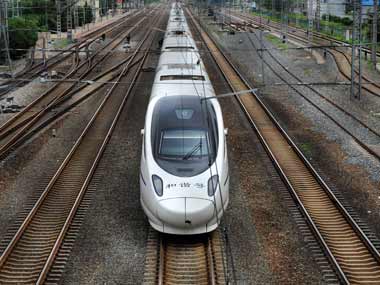China and India may not agree on where their boundaries run, and may be waging cartographic war over Arunachal Pradesh, but their Strategic Economic Dialogue in New Delhi on Monday seemed keen to emphasise closer economic and trade cooperation as the antidote to the strains in their relations.
In particular, the two sides were believed to be exploring a tentative agreement to get Chinese technical know-how to upgrade India’s creaky railway system, and perhaps even develop high-speed railway networks of the sorts that now criss-cross China and have ‘shrunken’ the country, so to speak, for travelers. They were also to consider collaborating to upgrade major train stations and expand heavy freight railway haulage.
The Strategic Economic Dialogue between India and China, modeled on the US-China SED, was initiated in order to ensure that political frictions, of the sorts that keep cropping up from time to time - largely over the unresolved border dispute - do not spill over onto the realm of bilateral trade, which has boomed over the past decade, and the cooperation between the two countries on multilateral forums like the WTO and international Climate Change summits.
[caption id=“attachment_535772” align=“alignleft” width=“380”]  Does India really need one of these from China? Reuters[/caption]
That wish hasn’t entirely come true. The growing trade imbalance, which is heavily weighted in China’s favour has caused much anguish and heartburn among Indian officials. For all the evolution in their trade relationship, the terms of the trade are overly grotesque. Commodities and raw materials make up much of India’s exports to China, whereas finished goods from China make up the bulk of the reverse trade. And with iron ore exports from India slowing down in recent months, the trade imbalance has been accentuated even further.
India has urged China to relax controls on Indian exports in the area of services and pharma sectors, but that hasn’t been forthcoming. Yet, India perseveres, wary of escalating the rhetoric on the only area that is touted as a success in their bilateral relations.
And now, it is evidently looking to ‘grease the tracks’ by getting China to collaborate on modernizing its railway system. But although it’s being projected as an area of cooperation, the move has the potential to accentuate the skewed nature of the trade imbalance, and give rise to yet more heartburn on the Indian side.
That the Indian railway system is in dire need of upgradation is not in doubt. But the wisdom of looking to embrace high-speed rail technology from China is fraught with several risks.
The first of these is the macro picture on the economics of high-speed railway systems. Building a high-speed railway system is a capital-intensive undertaking, and typically the costs and borrowings are laid on upfront in order to finance the laying of new tracks, and the new railway cars and locomotives. That investment can be recouped only over years even if the fare is high enough to offer a sufficient return on investment.
As this World Bank study, conducted in 2010, established: “The demographic and economic conditions that can support the financial or economic viability of high-speed rail are limited… High-speed projects have rarely met the full
ridership forecasts asserted by their promoters and in some cases have fallen far short. The overall financial performance of high-speed train services depends on enough people being able to pay a premium to use them.”
Many projects, it observed, took long periods to complete (in many cases, over a decade) creating a heavy capital and debt burden before any cash in-flows. “And any delay in the passenger ramp-up period, or a shortfall in ridership or yield, can quickly create financial stress. Many lines internationally have run into trouble and had to have either restructure debt or seek additional funding from Government.”
Given the political reality of India, where railway fares haven’t been hiked in years, thereby effectively running the railway budget to the ground, it is hard to visualize a situation where populist-minded politicians will contemplate pricing fares sufficiently high in order to render high-speed railway commercially viable. And given the huge delays that typically characterize projects in India, this could prove to be as big white elephant, one that trundles at 250 kmph. That’s a recipe for disaster, and will only compound the enormous holes in the budget that the inevitable bailout of the aviation industry in India will have caused.
Second, China’s high-speed rail technology, which was essentially ripped off from the Japanese but integrated fitfully with Chinese hardware, has been on test for two years now. The July 2011 mishap, involving two high-speed trains in Wenzhou in eastern China, focused attention on the flawed technology and the manner in which safety considerations were overlooked in the rush for results and showcase high speeds.
And although there have not been any grievous mishaps involving high-speed railway systems in China, the trains have had to be slowed down as a concession to safety considerations, which has diminished their appeal from the time they were launched. Even as of now, China’s high-speed railway service hasn’t yet met the quality threshold - no satisfactory enquiry was conducted into the accident, and in fact the haste with which the authorities buried a high-speed rail compartment involved in the accident evoked uncharacteristic protests. Which is why there is a case for prudence on India’s part - rather than rushing into an agreement to import their technology.
It is true, of course, that sometimes it’s easier to build from the scratch than to upgrade an existing creaky railway system. But the skewed economics of high-speed rail systems, our politicians’ incapacity to price fares right, and the imperfect nature of the Chinese technology, all it a high-risk, low-return endeavour.


)
)
)
)
)
)
)
)
)



